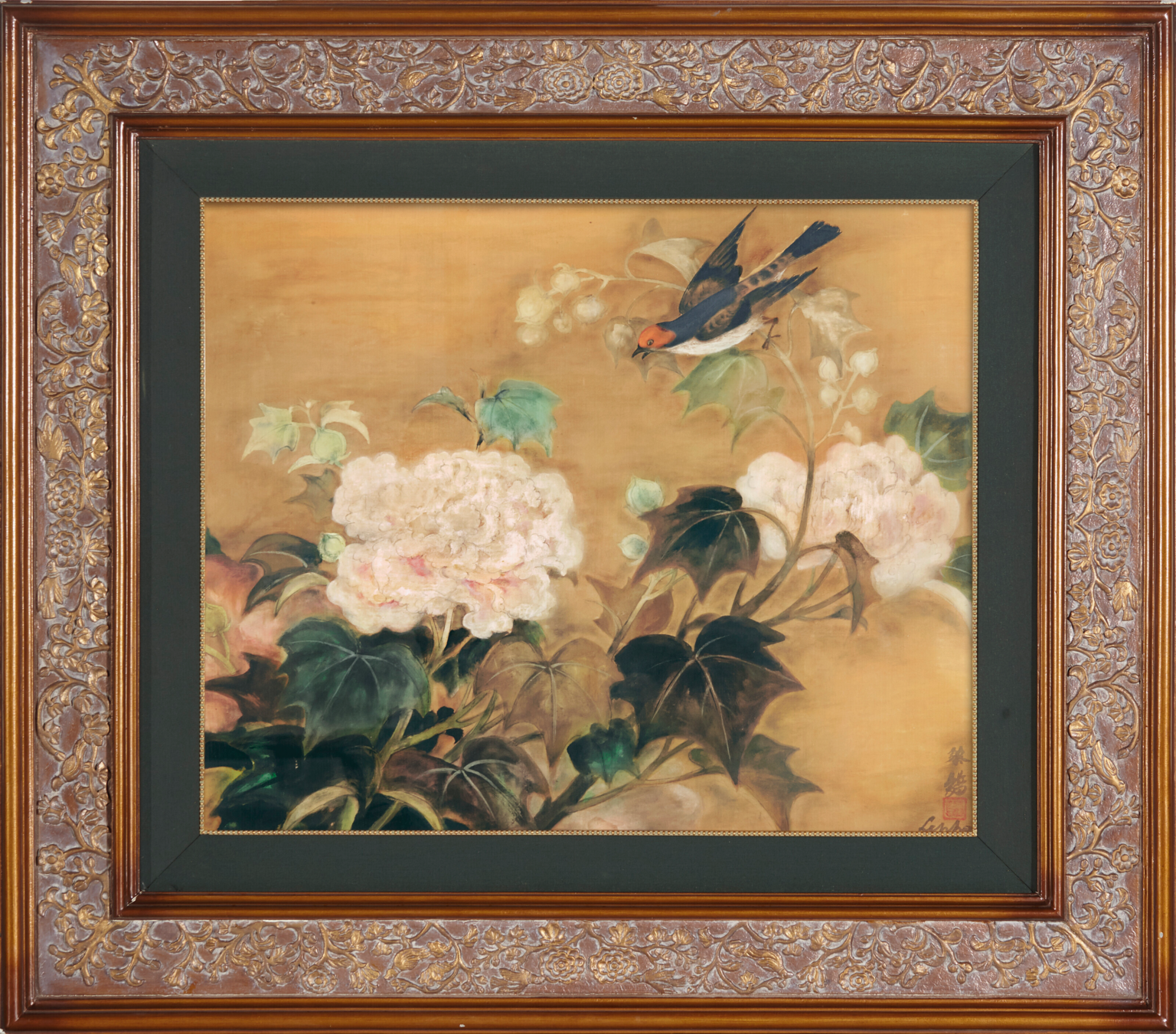
Le Pho (1907-2001)
Oiseau et pivoines (Bird and Peonies)
signed in Chinese and signed again ‘Le pho’ (lower right)
ink and gouache on silk
59 x 72 cm. (23 1/4 x 28 3/8 in.)
Painted circa 1936
one seal of the artist

Oiseau et pivoines (Bird and Peonies) is unique for Le Pho and one of the most exceptional works in terms of subject matter, style and period.
Le Pho often painted women, children, flowers, some landscapes, religious scenes, still lifes, and once even fish, such as Les Poissons Rouges (The Goldfish) from Tuan Pham’s Collection (Christie’s Hong Kong, 24 November 2019, lot 110). Within his oeuvre, which comprises a diverse range of subjects, it is rare to find paintings of birds. Among the few, we can cite two later works: a scene of two turtledoves perched on a bamboo fence painted in 1937 (W. George, Le Pho, Paris 1970, n.p.), and Femme au perroquet (Lady with A Parrot), which was painted around 1938 and sold by Christie’s Hong Kong in 2020.
Le Pho never claimed to be a realist painter. Nature, for which he did not have any animosity, was only inspiring to him when at the service of the artist. Le Pho was a great lover of flowers which he rendered in their transient moment of existence. To the painter, nothing was forever. All things that were beautiful lasted for only a brief period of time. It was precisely such fleeting moments that the artist attempted to capture in his works.
The peony is significant. It is considered the ‘Queen of Flowers’, ‘Beauty of the Night’ and among ancient Chinese poets, a symbol of womanhood, feminine beauty and prosperity.
Surrounded by dark-coloured leaves, the large peonies occupy the space, guiding our eyes from the left to the right of the canvas, and bringing our attention towards the top where the bird arises above the dense flora. The bird, a Chim sâu đầu đỏ, otherwise known as a scarlet-headed flowerpecker, is endemic to Sulawesi but can be found in Vietnam, and is widely known for its singing.
Is the bird about to land or fly away? The question of staying or departing may have also resonated with Le Pho, who was abounded for a life in the West.
While most of Le Pho’s works can be broadly attributed to one of the three periods (early, Romanet, Findlay), proposing a precise date of execution may be a difficult task. The artist did not date or keep a record of many of his works. He lived his time without counting. As such, lists of exhibitions with similar titles can lead to confusion. I will allow myself to draw a personal anecdote about my time with the artist and his wife Paulette in their beautiful apartment in rue de Vaugirard, Paris. For hours, we discussed when his works were made, years of which even the artist was hesitant to confirm, including those ‘specified’ in the book by Waldemar George. The debate in art is never-ending. Putting on her elegant smile, Paulette often got out of this discussion by saying: ‘Don't ask me any questions prior to 1945, I don't know anything about it.’ 1945 was the year she and her husband first met.
Nevertheless, by carefully studying several elements, we may be able to speculate Oiseau et pivoines (Bird and Peonies)’s year of execution. Before this period, in the early 1930s, Le Pho typically left the background of his works uncoloured; see for example, Jeune Fille en Blanc (Young Girl in White), which was sold at Christie’s Hong Kong on 29 November 2010 (lot 1579). Similarly to Bouquet de lys (Bouquet of Lilies), sold at Christie's on 30 November 2022 (lot 9), the background is applied with a brown wash. In addition, the pastel-toned pigments, the medium-sized stamp and a calligraphic signature in Romanised letters all suggest that it was made around 1936. A painting dated 1942 by the artist and executed in France, Les Pivoines, sold by Christie’s Hong Kong in 2016 (lot 322), shows the later evolution. In that work, the artist subtly modified his style and begins using the cross-hatching technique, depicts lotus and enhances the general brightness. He also began to sign with a simple French signature without a seal or Chinese characters.
Oiseau et pivoines (Bird and Peonies) also echoes Le Pho’s inspirations during his stay in Beijing in 1934, where he visited the National Museum, the Palace Museum and some private collections where he saw ancient Chinese paintings.
Le Pho renders the bird in greater detail and colour than the rest of the composition, which appears more stylised. In a floating environment, the bird is in movement; its wings spread, legs extended, its scarlet head and wide-opened beak accentuating its dynamism. Le Pho refuses the ideal; he paints a real bird, the kind we like to observe and listen to, hoping that the inevitable departure doesn’t ever happen. The observer will say that the bird has escaped, but the artist would have perceived its flight as a liberation. The peonies will wither, the bird will take flight, and only the work of art will remain.
Le Pho knows: nostalgia is unavoidable, but freedom is the ultimate quest of this earthly existence. The wings spread open, and the flight begins. The two beautiful flowering peonies and their 15 promising buds will not hold the artist back. When he paints this scene, Le Pho knows he will fly to the West, where his destiny awaits him–the destiny of an artist in search of eternity.
Jean-François Hubert
Senior Expert Vietnamese Art










